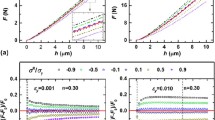Abstract
Several methods for determination of elastic–plastic parameters by instrumented spherical indentation tests have been presented in the past few years. Each method was established according to a specific constitutive model. Identification of the constitutive models of new materials has become an indispensable step in order to choose an appropriate indentation method to extract the elastic–plastic parameters. In the present work, the half depth energy accumulation rate and Meyer’s index were related to the elastic–plastic constitutive models via qualitative and numerical analyses. A method for identification of the elastic–plastic constitutive models by instrumented spherical indentation test was proposed.










Similar content being viewed by others
References
N. Choppacoop, M. Dao, and S. Suresh: Depth-sensing instrumented indentation with dual sharp indenters. Acta Mater. 51, 3713 (2003).
S. Swaddiwudhipong, K.K. Tho, Z.S. Liu, and K. Zeng: Material characterization based on dual indenters. Int. J. Solids Struct. 42, 69 (2005).
J.S. Field and M.V. Swain: Determining the mechanical properties of small volumes of material from submicron spherical indentations. J. Mater. Res. 10, 101 (1995).
Y.P. Cao and J. Lu: A new method to extract the plastic properties of metal materials from an instrumented spherical indentation loading curve. Acta Mater. 52, 4023 (2004).
X.L. Gao and X.N. Jing: Two new expanding cavity models for indentation deformations of elastic strain-hardening materials. Int. J. Solids Struct. 43, 2193 (2006).
A. Hasanov: An inversion method for identification of elastoplastic properties for engineering materials from limited spherical indentation measurements. Inverse Probl. Sci. Eng. 15, 601 (2007).
P. Jiang, T.H. Zhang, Y.H. Feng, R. Yang, and N.G. Liang: Determination of plastic properties by instrumented spherical indentation: expanding cavity model and similarity solution approach. J. Mater. Res. 24, 1045 (2009).
G. Maier, V. Buljak, T. Garbowski, G. Cocchetti, and G. Novati: Mechanical characterization of materials and diagnosis of structures by inverse analyses: some innovative procedures and applications. Int. J. Comput Methods 11, 1072 (2014).
V. Buljak, G. Cocchetti, A. Cornaggia, and G. Maier: Assessment of residual stresses and mechanical characterization of materials by “hole drilling” and indentation tests combined and by inverse analysis V. Mech. Res. Commun. 68, 18 (2015).
C. Yu, Y.H. Feng, R. Yang, G.J. Peng, Z.K. Lu, and T.H. Zhang: An integrated method to determine elastic-plastic parameters by instrumented spherical indentation. J. Mater. Res. 29, 1095 (2014).
C. Yu, R. Yang, Y.H. Feng, Y. Huan, G.J. Peng, and T.H. Zhang: Relationships between the work recovery ratio of indentation and plastic parameters for instrumented spherical indentation. MRS Commun. 5, 89 (2015).
Y.T. Cheng and C.M. Cheng: Can stress-strain relationships be obtained from indentation curves using conical and pyramidal indenters. J. Mater. Res. 14, 3493 (1999).
K.L. Johnson: The correlation of indentation experiments. J. Mech. Phys. Solids 18, 115 (1970).
R. Hill: The Mathematical Theory of Plasticity (Oxford University Press, New York, 1998).
Acknowledgments
Authors gratefully acknowledge the financial support from the National Natural Science Foundation of China (Grant numbers 11672356, 11272318, 11402233, and 11302231).
Author information
Authors and Affiliations
Rights and permissions
About this article
Cite this article
Zhang, T., Yu, C., Peng, G. et al. Identification of the elastic–plastic constitutive model for measuring mechanical properties of metals by instrumented spherical indentation test. MRS Communications 7, 221–228 (2017). https://doi.org/10.1557/mrc.2017.28
Received:
Accepted:
Published:
Issue Date:
DOI: https://doi.org/10.1557/mrc.2017.28




